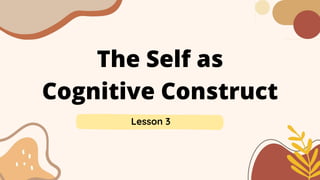
LESSON 3 THE SELF COGNITIVECONSTRUCT.pptx
- 1. The Self as Cognitive Construct Lesson 3
- 2. As mentioned earlier, there are various definitions of the "self" and other similar or interchangeable concepts in psychology. William James was one of the earliest psychologists to study the self and conceptualized the self as having two aspects - the "I" and the "me". The "I" is the thinking, acting, and feeling self. The "me" on the other hand, is the physical characteristics as well as psychological capabilities that makes who you are.
- 3. Other concepts similar to self are identity and self concept. Self Identity - is composed of personal characteristics, social roles, and responsibilities, as well as affiliations that define who one is. Self concept - is what basically comes to your mind when you are asked about who you are.
- 4. Self identify and self concept are not fixed in one time frame. They are not also fixed for life nor are they ever-changing at every moment. Basically, Sigmund Freud saw the self, it's mental processes, and one's behavior as the results of the interaction between the 'Id', 'ego', and the 'superego'.
- 5. Id - the impulsive part of your personality that is driven by pleasure and repulsed by pain. Ego - the conscious part of your personality that mediates between the id and the superego and makes decisions. Superego - the judgmental and morally correct part of your personality.
- 6. Under the theory of symbolic interactionism, G.H. Mead argued that the self is created and developed through human interaction. There are three reasons why self and identity are social products. 1. We do not create ourselves out of nothing. Society helped in creating the foundations of who we are and even if we make our choices, we will still operate in our social and historical contexts in one way or the other.
- 7. 2. Whether we like to admit it or not, we actually need others to affirm and reinforce who we think we are. We also need them as reference points about our identity. 3. What we think is important to us may also have been influenced by what is important in our social or historical context.
- 8. Social interaction and group affiliation, therefore, are vital factors in creating our self-concept especially in the aspect of providing us with our social identity or our perception of who we are based on our membership to certain groups.
- 9. When we are aware of our self concepts; this is also called self awareness. There are two types of self that we can be aware of: 1. The private self or your internal standards and private thoughts and feelings. 2. The public self or your public image commonly geared toward having a good presentation of yourself to others.
- 10. Self-awareness also present us with at least three other self schema: • Actual self - is who you are at the moment • Ideal self - is who you like to be •Ought self - is who you think you should be
- 11. Self-awareness may be positive or negative depending on the circumstances and our next course of action. Self awareness can keep you from doing something dangerous; can be too much that we are concerned about being observed and criticized by others, also known as self- consciousness.
- 12. Our group identity and elf-awareness also has a great impact on our self-esteem, one of the common concepts associated with the "self". It is defined as our own positive and negative perception or evaluation of ourselves. One of the ways in which our social relationship affects our self-esteem is through social comparison. According to the social comparison theory, we learn about ourselves, the appropriateness of our behaviors, as well as our social status by comparing aspects of ourselves with other people.
- 13. Downward social comparison - The common type of comparing ourselves with others. We create a positive self-concept by comparing ourselves with those who are worse off than us. Upward social comparison - comparing ourselves with those who are better off than us.
- 14. Self comparison also entails what is called self-evaluation maintenance theory, which states that we can feel threatened when someone out-performs us, especially when that person is close to us. However, in the attempt to increase or maintain self-esteem, some people become narcissistic. Narcissism - a trait characterized by overly high self-esteem, self admiration, and self-centeredness.
- 15. People with high self-esteem are commonly described as outgoing, adventurous, and adaptable in a lot of situations. They also initiate activities and building relationships with people.